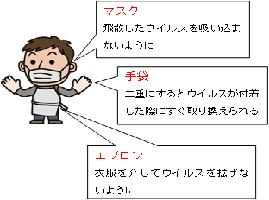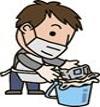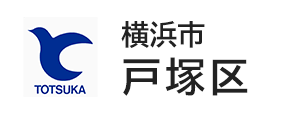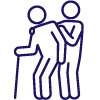- Yokohama-shi Top Page
- Totsuka Ward Top Page
- Health, medical care, welfare
- Health, medical care
- Vaccinations Infectious Diseases
- Norovirus (infectious gastroenteritis) and influenza
The text is from here.
Norovirus (infectious gastroenteritis) and influenza
Last updated on December 27, 2024.
<To those involved in the facility>
In childcare facilities, social welfare facilities, nursing homes for the elderly, etc., there are patients with symptoms such as diarrhea and vomiting, and there are cases where influenza diagnosis and flu-like symptoms occur, and if there is a tendency to spread, please contact Health and Welfare Center immediately.
"Report at the time of infectious disease occurrence in social welfare facilities, etc. (February 22, 2017) Notice of Director-General of the Ministry of Health, Labor and Welfare"
[Report Standards]
- When two or more fatalities or serious patients occur due to the same infectious disease or food poisoning or suspected to be due to them within one week
- When there are more than 10 patients with infectious diseases or food poisoning in the same room or suspected persons or more than half of all users.
- Even if it does not fall under 1 and 2, it is suspected that infectious diseases, etc. that exceed normal outbreak trends, especially when the facility manager deems necessary to report.
We may ask you to submit an epidemiological questionnaire. In that case, please download it from the following and fill it out including weekends and holidays.
- Active epidemiological questionnaire (gastroenteritis) PDF format (PDF: 113KB)
- Active epidemiological questionnaire (gastroenteritis) Excel format (Excel: 14KB)
- Active epidemiological questionnaire (flu) PDF format (PDF: 112KB)
- Active epidemiological questionnaire (flu) Excel format (Excel: 14KB)
Materials on correct hand washing method (PDF) (PDF: 402KB)
At the same time, please check the website of Yokohama City.
[Yokohama City] About infectious gastroenteritis (norovirus, etc.)
[Yokohama City] About influenza (seasonal influenza)
[Submission address]
Totsuka Ward Health and Welfare Center Health and Welfare Division Health Promotion Section: [email protected]
<To the general public>
■Norovirus (infectious gastroenteritis)
Infectious gastroenteritis due to norovirus occurs throughout the year, but it is said to spread every year from November to March. Norovirus is a very small virus, which is highly infectious and resistant to drying even in small quantities. When infected, symptoms such as diarrhea, vomiting, fever, and abdominal pain appear in 1-2 days, and usually recover in 1-2 days after onset. Some people don't have any symptoms when infected. One week after the subjective symptoms disappear, and those who are longer need to be careful because the virus continues to shed from the stool for about a month.
<Symptoms>

Fever

Diarrhea and abdominal pain

Nausea, vomiting
<Infection route>
(1)Food → Human
Infects bivalve, which has accumulated norovirus, is eaten raw or not heated enough.
(2)Human → Food → Human
infected person puts norovirus on food during cooking, and eats it to infect another person.
(3)Human → Human
・When treating infected person's vomit, norovirus is attached to the fingers and enters the mouth through the fingers and becomes infected.
・Infects by inhaling dry and floating norovirus.
<Prevention>
(1)Heat and heat at the center temperature of 85 ° C or more for at least 1 minute.
・Wash cooking utensils such as cutting boards and kitchen knives, towels, and tableware immediately after use, and heat them with boiling water at 85 ° C for at least 1 minute to take measures.
(2)Hand washing

・Be sure to wash your hands frequently when you return home, before cooking or after the toilet.
・Cut your nails short and remove your rings and watches before hand washing.
| Order | 1 | 2 | 3 | 4 |
|---|---|---|---|---|
| Explanation | First of all, remove the dirt thoroughly with running water. | Put soap and lather well to the back of both hands, the base to fingertips, between wrinkles and fingers, and the thumbs that you tend to forget. Estimated lathering time is 30 seconds. A nail brush is effective especially for cleaning nails that are difficult to wash. | Wash off dirt that has been raised with soap thoroughly with running water. The guide here is until you get slimy. | Remove the water with a clean towel and dry your hands. I'd like to have my own or a paper towel. |
| Illustration |
|  |
|
|
☆~ Areas that require attention for hand washing ~


※Reference: As for the details, please see document (PDF: 402KB) of correct hand washing method.
(3)Disinfection
・Acids and alcohol are not very effective.
・Use sodium hypochlorite disinfectant to disinfect vomit and stool.
・Cooking utensils should not only be heated, but also be thoroughly washed before disinfecting with a chlorine-based disinfectant.
<If so>
・There are no vaccines or drugs that are effective against norovirus.
・Do not drink diarrhea or nausea at your own discretion, as it is very dangerous.
・If diarrhea or vomiting persists, provide sufficient hydration and nutrition. Infants and the elderly with weak resistance may have dehydration due to diarrhea. If your symptoms worsen, consult a medical institution.
・Wipe the toilets used and places where the hands touch well (doorknobs, handrails, etc.) with sodium hypochlorite disinfectant.
<How to treat vomit and stool>
Treatment of vomit and stool may seem easy at first glance, but if it cannot be processed in an appropriate manner, the infection may spread or the person who is treating it may be infected.
- Let's prepare a waste treatment set so that you can respond immediately!
Example of a waste treatment set: Chlorine bleach (sodium hypochlorite), disposable mask, disposable gloves, disposable aprons, disposable towels (paper towels, newspapers, multiple plastic bags, dilution equipment (plastic bottles, buckets), hand washing soap) 
- Clothes at the time of processing: Mask: Don't inhale the scattered virus. Glove: If it is doubled, it can be replaced immediately when the virus is attached. Apron: Don't spread the virus through clothes.

| Order | Illustration | Explanation |
|---|---|---|
| 1 |  | Open the window and ventilate it. |
| 2 |  | Cover with newspaper or towel soaked with 0.1% chlorine bleach. |
| 3 |  | Wipe off the dirt so that it does not spread. |
| 4 |  | Prepare a bucket with a garbage bag (double) and throw away 3 so that it does not touch the outside of the garbage bag. At this time, we throw away dirty gloves together. |
| 5 |  | Spray newspaper on the area where the filth has scattered, apply a disinfectant and soak for about 10 minutes. |
| 6 |  | Discard the newspaper in the same way as 3.4 and apply plenty of disinfectant. |
| 7 |  | Close the mouth of the garbage bag tightly. |
| 8 |  | Take it off without touching the outside of contaminated gloves and throw it away in a garbage bag. |
| 9 |  | Use soap to wash your hands thoroughly. |
<Notes on vomit and stool treatment>
・Do not make the disinfectant because the diluted disinfectant will be effective over time.
・The filth scatters over a wide area. Disinfect not only where there is dirt, but also a circumference radius of 2-3m (not only floors but also walls).
・Be careful not to hold your knees during processing.
・Chlorinated disinfectants are metal corrosive, so wash them with water or wipe them immediately after disinfection. When used for clothes, carpets, etc., the color may fade.
<How to make a disinfectant solution>
・Most commercially available chlorine-based disinfectants have a concentration of about 5 to 6%. Dilut it with water to the specified concentration when used.
| What to disinfect | Concentration | How to dilute |
|---|---|---|
| Handrails, doorknobs, etc. | 0.02% | 500ml of water in a chlorinated bleach with half the cap (2.5CC) of a plastic bottle. |
| Vomit and stool | 0.1% | 500ml of water in 2 caps (10CC) chlorine bleach for PET bottles. |
■Flu
It is caused by infection with influenza virus. It is popular every year from December to March. The period from infection to onset is short and the infectiousness is very strong, so once the epidemic begins, the infection spreads to many people. Elderly people and infants are more likely to become severe, so it is important to respond early.
<Symptoms>

Sudden fever of 38 degrees or higher, sore throat, general laxity, joint pain, muscle pain
<Infection route>
(1)"Flying infection" by inhaling the virus contained in a patient's cough or sneezing.
It is said that if you cough or sneeze without a mask, the splash will fly 1-2 meters.
(2)"Contact infection" by touching the mouth or nose with a virus-attached hand
<Prevention>
・Let's wash your hands frequently.
・Avoid crowds and wear a mask when going out.
・Keep a moderate humidity (50-60%) indoors and get enough nutrition and sleep.
・Improve your body's resistance with enough rest and a well-balanced diet.
・Get vaccinated before the epidemic (around October-November). It is said that the possibility of onset can be reduced and the effect of preventing the severity of the disease even if it occurs. The duration of the vaccine lasts about 2 to 5 months after vaccination.


<If so>
・See you as soon as possible!
・Be sure to take the prescribed medicine even if it disappears.
・Even if the fever has subsided, the virus remains in the body for a while, so let's recuperate at home for 2 days. The School Health and Safety Act stipulates that the suspension period is "until 5 days have passed since the onset and 2 days after the fever has resolved (3 days for infants)."
<Cough Etiquette>

・When coughing or sneezing, hold your mouth and nose with a tissue and turn your face away from people around you.
・Immediately discard tissues containing sputum and nasal discharge in a trash can with a lid.
・If you have prevented coughing or sneezing by hand, wash your hands immediately.
<To medical institutions>
Occurrence notification standards and notification of outbreaks of Class 1 to 5 infectious diseases
Yokohama City Inst. of Health Web page
You may need a separate PDF reader to open a PDF file.
If you do not have it, you can download it free of charge from Adobe.
![]() To download Adobe Acrobat Reader DC
To download Adobe Acrobat Reader DC
Inquiries to this page
Totsuka Ward Health and Welfare Center Health and Welfare Division
Phone: 045-866-8426
Phone: 045-866-8426
Fax: 045-865-3963
E-Mail address [email protected]
Page ID: 865-760-217
















